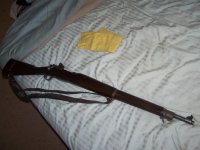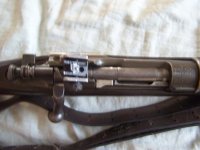
The dawn of the 20th Century saw new developments in the field of small arms design. Smokeless powder was revolutionizing the ammunition industry, allowing cleaner firing, less smoke and easier cleaning of the firearm. The turnbolt Mauser design was accepted as the new de facto standard, and based on that firearm, the United States developed a much stronger and more sophisticated arm than the older Krag-Jorgensen rifle. The Model 1903 “Springfield” rifle served our nation in one form or another for over 50 years. Highly accurate, powerful, rugged, simple to operate, field strip and clean, the Model 1903 easily joins the ranks of classic military rifles.
United States forces first came up against Mauser rifles in the hands of Spanish troops during the Spanish-American War in Cuba. Our men were armed with the old .45-70 “trapdoor” black powder single shots and the recently-adopted Krag-Jorgensen repeaters. The Krag rifles and carbines required that rounds be inserted individually into the flip-down side-mounted magazine. The Mausers, on the other hand, could be more rapidly loaded five at a time by stripper clips. Also, the dual-lug design of the Mauser allowed for a more powerful cartridge. The Krag had only one locking lug, so it couldn’t handle the increased stress of high-velocity rounds. And so the die was cast, and trials began of prototypes of a new rifle based on the Mauser design.
In 1900, a prototype rifle was crafted at Springfield Armory in Springfield, Massachusetts. It had a clip-loaded single-stack magazine which projected below the stock, and a 30-inch barrel. Following tests, an Ordnance Department board recommended certain changes, including a rimless cartridge, a staggered-row magazine contained entirely within the stock, and an improved magazine-cut-off lever. In 1901, an improved prototype incorporating the recommended changes was made. It also featured a rod bayonet. Probably less than 40 of these rifles were virtually hand-made. Most had 30-inch barrels, although some carbines with 22-inch barrels were assembled. Following additional tests, the Ordnance board recommended that the barrel length be standardized at 24 inches (so the same rifle could be used by both infantry and cavalry) and that the rod bayonet be retained. It was to be chambered for a .30 caliber rimless round using round-nose bullets identical to those used in the Krag.
On June 19, 1903, the new rifle was formally adopted as the U.S. Magazine Rifle, caliber .30, Model of 1903. Both Springfield and Rock Island (Illinois) armories were instructed to begin production. Manufacture began at Springfield in November 1903 and at Rock Island in December 1904. Some relatively minor changes were made in rifling twist and cartridge power in order to reduce bore erosion. The rear sight was similar to the 1902 model used on the Krag, with a curved profile. The distinctive front sight had two holes below the blade. A beautiful rust-blued finish was applied. A hinged cap in the butt plate allowed access to a recess in the stock that contained an oiler and a screw-on head for the rod bayonet to allow its use as a cleaning rod. A few over 30,000 of these first rifles were issued. The fit and finish of these initial rifles rivaled commercial sporter rifles.
Obviously, the new arm was based on the Model 1898 Mauser, and the Mauser Company in Germany claimed seven patent infringements. An agreement between the U.S. and Mauser was made. It called for royalties of 75 cents per rifle, and 50 cents per thousand stripper clips until a total of $200,000 was paid. The final installment on this debt was paid in July 1909.
In 1905, at the insistence of combat veteran President Theodore Roosevelt, the rod bayonet was abandoned and almost all existing rifles were retrofitted to accommodate a 16-inch blade bayonet. This was designated as the M1905. President Roosevelt called the flimsy rod bayonet “the poorest invention I ever saw” after personally testing it. Also a new rear sight calibrated to 2,500 yards was fitted. The front sight base was solid, eliminating the two holes. The rifle illustrated for this article, now over 100 years old, was made in January 1906 at Springfield. It originally was a converted 1903 pattern chambered for the .30-03 cartridge. In 1912 it was called in to the Armory for cleaning and repair, and at that time was fitted with a new barrel made in 1908, chambered for the .30-06 cartridge. It was black-phosphate finished during the WWII period and shows heavy stock wear over its considerable life span.
On October 15, 1906, the improved .30-06 cartridge was made standard. It had a lighter, pointed spitzer bullet and improved powder that promised less barrel erosion. German claims of patent infringements on this round were made moot with our entry into WWI. All rifles previously chambered for the .30-03 were to be recalled and rechambered or rebarreled and fitted with newer sights calibrated to 2,800 yards. A very few original 1903 and 1905 pattern arms survived this mandatory retrofitting, and are extremely valuable collector’s pieces today. Springfield rifles below serial number 800,000 and Rock Island rifles below number 285,507 had an earlier heat treatment that resulted in receivers that were sometimes brittle. Therefore ‘03s which are to be shot today are recommended to have serials above those numbers, although many “low-numbered” arms have been shot with no problems.
The 1903 Springfield rifle was our standard service rifle during the Punitive Expedition to Mexico in 1916 and throughout WWI (although the Model 1917 “Enfield” was issued in larger numbers). There was a 1903 Mark I rifle designed for the top secret “Pedersen Device” (never used in battle) which could fire .30 caliber pistol-power cartridges semi-automatically. This variation had an oval ejection port in the receiver on the left side. A 1903A1 version with a curved pistol grip appeared during the 1920s. There was a 1903A2, but it was a subcaliber spotting device for artillery training, not a shoulder weapon. Remington made some standard 1903s in the early days of WWII on Rock Island machinery. A cheaper-to-produce 1903A3 rifle was made by Remington and Smith-Corona Typewriter Company during WWII. The ‘03A3 had a receiver-mounted rear peep sight and many stamped parts. The 1903A4 was a WWII scope-mounted sniper version of the 1903A3, and it served honorably as late as the Korean War. Most of these had 2.5x power Weaver 330C (M73B1) scopes. Specially-made Unertl-scoped 1903s were used by the Marines as sniper rifles in WWII and Korea. Although officially replaced by the M1 Garand rifle in 1936, the 1903, 1903A1, 1903A3 and 1903A4 rifles were widely issued during WWII, particularly to the Marines in the early days of the Pacific theater of war.
The 1903 Springfield was one of the most accurate battle rifles ever made and was employed in combat effectively even through the advent of standard semiautomatic weapons such as the M1 Garand. The “brown shoe” veterans spoke of them lovingly. Today, collectors earnestly seek out examples of most of the variations. Because many surplus ‘03 and ‘03A3 rifles were “sporterized” by civilians in the years following WWII, original unaltered service arms have skyrocketed in value over the past few years. The “03” has become an American icon and is easily and deservedly a classic military rifle.
I do love the venerable '03s and have a number of them, some of which can be seen in the "Pictures and Albums" section of this forum, under "U.S. .30-06 military rifles." They make a fascinating field for collectors interested in U.S. military history.
Hope you find this summary interesting.
John






